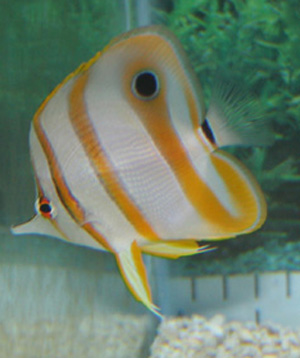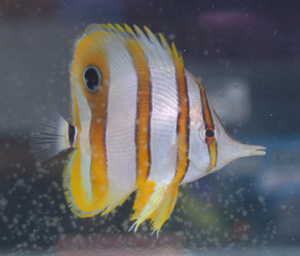|
|
Copperbanded Butterflyfish – Chelmon rostratus
The copperbanded butterflyfish, also called the beaked coralfish, comes from the Indo-Pacific ocean region. The copperbanded is not a fish for the beginner, this fish needs high water quality and may not make an easy transition to a new tank. The copperbanded butterflyfish is best left for the more experienced to own. 
Maximum Size: The copperbanded butterflyfish should grow to a maximum size of 7.9 inches
Minimum Tank Size: The minimum tank size should be 75 gallons
Care Level: The copperbanded butterflyfish is a difficult fish that as stated may not make an easy transition to a new tank. On a scale of 1 –10, (10 being easy) it would rate a “4”. The tank should already be cycled and considered mature.
Tank Conditions: Temperature 77-79°F; Specific gravity: 1.021 – 1.024; pH: 8.1 – 8.3; Nitrates should be no more than 10 ppm.
Color: The copperbanded butterflyfish – as picture shows is a spectacular fish. It has an extended snout and copper bands that run vertical on its body. A black dot (false eye) is on the back end of its dorsal fin.
Temperament: This is a good fish. It can ultimately become aggressive to other copperbanded butterflyfish and fish closely colored as well as more meek fish kept in the aquarium. You can possibly maintain a male and female together – they should be introduced to the tank together.
Reef Compatible: May eat at and possibly destroy hard and soft corals as well as invertebrates, anemones. If put into a reef tank – take care.
 Diet: The copperbanded butterflyfish is an basically a carnivore Typical meaty foods such as brine shrimp, clams, fish meat etc that can be purchased from your local store should be provided. Diet: The copperbanded butterflyfish is an basically a carnivore Typical meaty foods such as brine shrimp, clams, fish meat etc that can be purchased from your local store should be provided.
Habitat: Provide with plenty of hiding places. Good water circulation is important as well as high quality water maintenance. Filtration should include a protein skimmer and activated carbon filtration.
Compatibility: Butterflyfish in general can be kept with cardinalfish, catfish, filefish, firefish, gobies, grammas, rabbitfish to name a few and they should not be housed with groupers, sharks, lionfish or rays and can be a problem if housed with damselfish, basslets, surgeonfish, triggerfish and certain wrasses.
|
|
|
|



 Diet: The copperbanded butterflyfish is an basically a carnivore Typical meaty foods such as brine shrimp, clams, fish meat etc that can be purchased from your local store should be provided.
Diet: The copperbanded butterflyfish is an basically a carnivore Typical meaty foods such as brine shrimp, clams, fish meat etc that can be purchased from your local store should be provided.